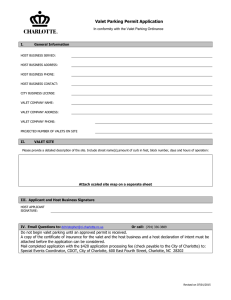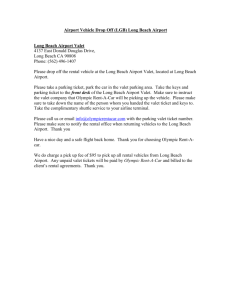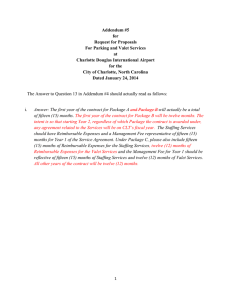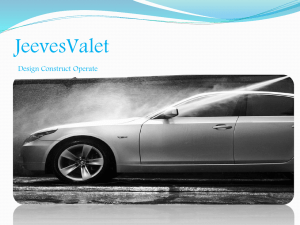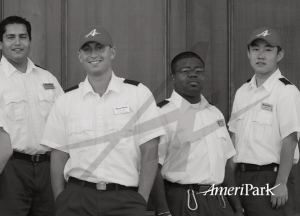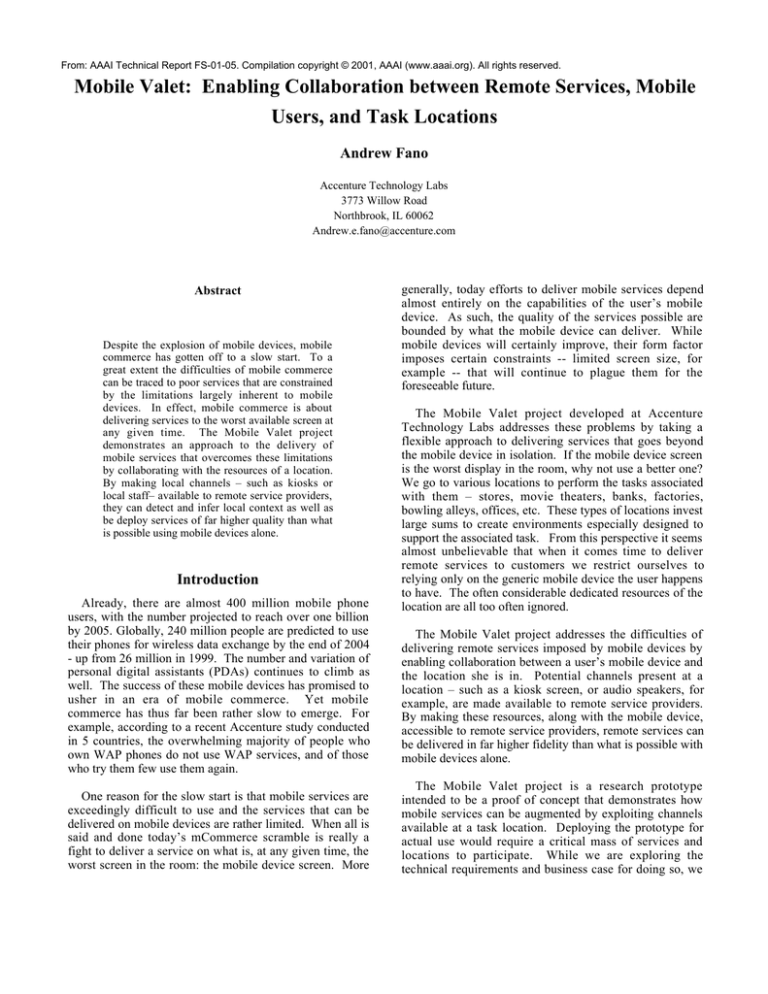
From: AAAI Technical Report FS-01-05. Compilation copyright © 2001, AAAI (www.aaai.org). All rights reserved.
Mobile Valet: Enabling Collaboration between Remote Services, Mobile
Users, and Task Locations
Andrew Fano
Accenture Technology Labs
3773 Willow Road
Northbrook, IL 60062
Andrew.e.fano@accenture.com
Abstract
Despite the explosion of mobile devices, mobile
commerce has gotten off to a slow start. To a
great extent the difficulties of mobile commerce
can be traced to poor services that are constrained
by the limitations largely inherent to mobile
devices. In effect, mobile commerce is about
delivering services to the worst available screen at
any given time. The Mobile Valet project
demonstrates an approach to the delivery of
mobile services that overcomes these limitations
by collaborating with the resources of a location.
By making local channels – such as kiosks or
local staff– available to remote service providers,
they can detect and infer local context as well as
be deploy services of far higher quality than what
is possible using mobile devices alone.
Introduction
Already, there are almost 400 million mobile phone
users, with the number projected to reach over one billion
by 2005. Globally, 240 million people are predicted to use
their phones for wireless data exchange by the end of 2004
- up from 26 million in 1999. The number and variation of
personal digital assistants (PDAs) continues to climb as
well. The success of these mobile devices has promised to
usher in an era of mobile commerce. Yet mobile
commerce has thus far been rather slow to emerge. For
example, according to a recent Accenture study conducted
in 5 countries, the overwhelming majority of people who
own WAP phones do not use WAP services, and of those
who try them few use them again.
One reason for the slow start is that mobile services are
exceedingly difficult to use and the services that can be
delivered on mobile devices are rather limited. When all is
said and done today’s mCommerce scramble is really a
fight to deliver a service on what is, at any given time, the
worst screen in the room: the mobile device screen. More
generally, today efforts to deliver mobile services depend
almost entirely on the capabilities of the user’s mobile
device. As such, the quality of the services possible are
bounded by what the mobile device can deliver. While
mobile devices will certainly improve, their form factor
imposes certain constraints -- limited screen size, for
example -- that will continue to plague them for the
foreseeable future.
The Mobile Valet project developed at Accenture
Technology Labs addresses these problems by taking a
flexible approach to delivering services that goes beyond
the mobile device in isolation. If the mobile device screen
is the worst display in the room, why not use a better one?
We go to various locations to perform the tasks associated
with them – stores, movie theaters, banks, factories,
bowling alleys, offices, etc. These types of locations invest
large sums to create environments especially designed to
support the associated task. From this perspective it seems
almost unbelievable that when it comes time to deliver
remote services to customers we restrict ourselves to
relying only on the generic mobile device the user happens
to have. The often considerable dedicated resources of the
location are all too often ignored.
The Mobile Valet project addresses the difficulties of
delivering remote services imposed by mobile devices by
enabling collaboration between a user’s mobile device and
the location she is in. Potential channels present at a
location – such as a kiosk screen, or audio speakers, for
example, are made available to remote service providers.
By making these resources, along with the mobile device,
accessible to remote service providers, remote services can
be delivered in far higher fidelity than what is possible with
mobile devices alone.
The Mobile Valet project is a research prototype
intended to be a proof of concept that demonstrates how
mobile services can be augmented by exploiting channels
available at a task location. Deploying the prototype for
actual use would require a critical mass of services and
locations to participate. While we are exploring the
technical requirements and business case for doing so, we
have no current regular users and therefore no formal
evaluation. Nevertheless, the Mobile Valet has been
implemented, and is regularly demonstrated to both
internal and external audiences that visit our research
facilities. Although the approach is broadly applicable to a
variety of task settings, for the purposes of this paper we
generally restrict ourselves to the context of an electronics
retail setting, the scenario that has undergone the most
development.
In the remainder of this paper we first describe the
Mobile Valet prototype, then describe the issues involved
in establishing and exploiting multiple service channels.
The Mobile Valet Project
The Mobile Valet is a program that resides on a user’s
PDA and presents services appropriate to the current task.
The value of the Mobile Valet is that it infers the task from
the user’s context and dynamically selects a small set of
services based on the task, the services that are locally
available, and existing service relationships the user may
have. Finally, when a service is selected, the Mobile Valet
makes the user’s context and locally available channels
available to the remote service.
We have constructed the Mobile Valet to work initially
in a retail scenario. We chose a retail scenario for a variety
of reasons. First and most obviously shopping is a familiar
task to those who view the prototype. Secondly, retail
locations tend to have (or would be inclined to have)
possible channels to customers such as kiosk screens, audio
speakers, printers, and ATMs, to name a few. Third, the
shopping task nicely illustrates a situation in which users
need a variety of supporting services and are often limited
to those available at the location, such as product
information, warranties, financing, customer service, etc.
These are services that they may wish to choose from third
parties rather than the particular retail establishment if it
could be done easily and smoothly. It is important to keep
in mind that neither the concepts nor the implementation
are retail specific.
Briefly, the retail scenario involves a customer
interested in an inkjet printer arriving at the printer
department of a consumer electronics store. The Mobile
Valet, presents remote services appropriate to shopping.
When particular services are presented they are initially
delivered only through the PDA. When the shopper is near
an available kiosk, the Mobile Valet offers the user the
ability to switch their context to the kiosk. The service is
then delivered primarily through the kiosk, but the mobile
device continues to be used to select services and provide
input to services. For example, a product comparison is
performed by pointing at the printers of interest with the
PDA, but the service is delivered on the kiosk. With
channels like the kiosk available, the remote service
provider now delivers a service that includes video, not just
the small bits of information possible on the PDA. Figure
1 shows the prototype in the context of this scenario. We
now describe the Mobile Valet in more detail.
The Mobile Valet prototype consists of a client program
residing on the user’s PDA, a server hosting the Mobile
Valet service, and resources at a location (such as kiosks)
that are “registered” with the Mobile Valet service. The
current prototype is deployed on an HP Jornada, a
Windows CE machine with access to the internet.
When the user arrives at the “printer department” a
designated area of our lab, the Mobile Valet senses the
location. Today we do this using an infrared beacon at the
location, but there are, of course, a variety of technologies
that could be used depending on the circumstances. Given
the growing interest in location-based services, as well as
the commercial interest many locations will have in being
identified, we believe approaches that involve selfidentification by locations are viable in the long-term, even
if this particular infrared-based approach remains a short
term solution driven by the current limitations of our
mobile device.
Once the location is established – the printer department
of our electronics store – the Mobile Valet infers the task –
shopping. Shopping is inferred, rather than delivery, for
example, because it is the task associated with the default
role of the “store” location type. Had an alternate role been
specified in the user’s profile for this location type, a
different task would have been inferred. Associated with
each task is a service template consisting of the broad
categories of supporting services appropriate for the task
and location. In this case the user is presented with the
following choices: Information, Customer Service,
Warranties, Financing, Directions. We have designed the
Mobile Valet to associate specific, recurring service
templates across location types to help present a uniform
and intuitive interface to needed services for particular
tasks and task locations. The default service template for
all stores, therefore, would consist of these service types,
although the specific services that support them will vary.
For a more detailed discussion of the service templates see
[Fano, 2001].
The shopper then selects a service category, say
Information. These service categories are not mapped to a
specific individual service. Instead, the Mobile Valet
dynamically selects a small set of available services using a
service discovery protocol implemented using eSpeak,
HP’s eservices framework. Briefly, in this framework
service providers publish their services to a “broker”.
When a service of a particular specification is required
Figure 1
The Mobile Valet retail scenario
(such as an inkjet printer reviews service for example) the
broker retrieves matching services and handles their
invocation, security, billing, etc. Preference is given to
those services provided by the location. In addition to
those services that are dynamically discovered, the
Mobile Valet makes available “preferred services” with
which a user might have an established relationship. The
result is that users are presented with a choice of services
including those with whom they have a relationship, those
provided by the location, and those that are particularly
suited to the circumstances.
A number of example services have been implemented
and “published” to the Mobile Valet service broker, and a
subset appear on the user’s device. In this case the user
may pick a product comparison service. Once selected
the user is instructed to point their mobile device at the
printers they’re interested in. The user then points their
device at two printers, which are identified by the service.
Once again, we currently accomplish this using infrared
beacons placed within the printers, but a variety of
alternate technologies could support similar functionality
such as RFID tags and barcodes. The broader purpose for
including this feature is to highlight what we expect will
be a growing role for mobile devices – acting as the eyes
and ears of remote service providers. In addition to
passively detecting certain contextual cues, such as
location, the mobile device can be used actively by the
user to “show” a remote service objects in their
environment (e.g. printers), or more generally, call
attention to relevant aspects of their situation.
Once scanned in, the user requests comparison, which
they receive on their PDA. We chose the Jornada in part
for its relatively generous screen size for a mobile device.
Despite this screen, in practice, the user can see precious
little information in the resulting comparison. However,
it is better than nothing when no alternatives are available.
But here the user happens to be near a kiosk. The Mobile
Valet service is aware of this kiosk because the location
had previously registered it as a resource it is willing to
make available. The user is then offered the opportunity
to switch their context to this kiosk.
Upon selecting this option the service is provided with
this additional channel to the user – the kiosk. The
service now delivers a higher fidelity version of the
service comprised of a more detailed and useful product
comparison. The PDA continues to be used as a channel
as well. It is used, for example, to select other services,
and point to other products. Upon focusing the selection
on an individual printer, the shopper now selects a
product review service that delivers a video review on the
kiosk screen.
Locations and Their Channels
We go to specific locations because they are
particularly well suited to do a particular task.
Presumably better than the place we just left.
Nevertheless, task locations can’t be good at everything,
that is, they can’t offer the best of every service. Ideally
we would like to have the best of both worlds. We’d like
to take advantage of the particular features of a location,
while bringing with us these best services – or at least our
trusted services, to complement the local offerings. The
Mobile Valet illustrates an approach through which these
services can be deployed, in part, using the resources –
the available channels of a location. After all, the
business that operate the locations we visit have made
significant investments in their assets. They want
customers to use these assets – for our purposes, the
channels available at a location -and succeed in their
tasks. It arguably follows that they should embrace a
solution that enables customers to use these channels in
concert with preferred service providers.
Note that these channels need not be restricted to
physical and technical assets. The staff of a location is a
potentially viable channel as well that would be
particularly useful to remote service providers. In the end
the most remote service providers can hope to do for a
user using only technology is provide information, media,
and enable transactions. They can’t do anything physical
in the local environment, but the local staff can. We are
currently exploring ways to enable collaboration between
remote service providers and the local staff of a store. For
example, as depicted in the final cell of figure 1, a local
sales person might retrieve needed accessories in response
to a remote service provider’s direction. We believe this
human assisted approach to collaboration between remote
and local service providers is promising and currently
underdeveloped.
This approach to service channels raises (at least) two
key questions: What must be done technically to the
resources of a location to enable them to act as a channel?
And perhaps more fundamentally, why would a location
open up its resources for use by other people’s services?
Today many of the resources one might find at a
location that one may want to enable as a service channel
are simply not suitable. Many kiosks, for example, are
closed systems. Increasingly, however, we find that
newer resources are online. From kiosks and ATMs to
ticket printers and gas station gas pumps, the devices
around us in locations where we likely want supporting
services are becoming connected to the Internet. Within
the next few years many of them will be short-range
wireless enabled. Bluetooth – an emerging short-range
wireless standard - for example, is expected to be
included in hundreds of millions of devices within less
than 2 years. Technologies such as these will make the
kinds of interactions described technically viable. Much
work remains, however, in establishing standards for how
remote providers might use these service channels along
with the customary challenges in getting early adopters of
such standards. We are currently working on ways to
address these issues.
Beyond the technical issues, locations will view
opening their locations to remote services as a doubleedged sword. While enabling customers to avail
themselves of remote services as described here may
enhance the experience of the customer – and by
extension arguably improve customer satisfaction, these
same services may call the customer’s attention to
competitor offerings. The temptation is to limit the
availability of remote services to those that do not present
any information contrary to the location – such as cheaper
prices elsewhere. We believe in the long run it is simply
not tenable to rely on a strategy of hiding available
information from customers because they can simply
leave and access the information they seek. In the end
locations have to succeed with enlightened customers.
Related Work
The Mobile Valet work work builds on an earlier
project, Shopper’s Eye, which focused exclusively on
location-based store offers [Fano, 1998]. More recently,
another Accenture Technology Labs project explored how
barcode scanner equipped PDAs could be used to perform
live price comparisons within a bookstore [Brody &
Gottsman, 1999].
More generally, there has been a significant amount of
work around ubiquitous computing that explores
interaction between a user, their devices and various
aspects of the environment and context. Weiser helped
define and launch much of the work in this area. See his
Scientific American piece for an early discussion of
ubiquitous computing [1991]. More recently and directly
related, see Schmidt, et. al, [1999] for an example realtime architecture that derives contextual cues from sensor
data. Such sensors might detect features including
position, sound, video, temperature, and location contents,
among others. These “bottom-up” contextual cues
combined with the “top-down” constraints offered by the
location’s task and the user’s input can be used to
determine the information to be presented to users and the
modality through which it should be presented. With
respect to the mobile interface, Beigl’s work on point and
click interfaces for control devices in the environment
[1999] shares certain parallels in the way mobile devices
are used to interact with objects in the environment.
Finally, McCarthy and Costa’s work on GroupCast is an
example of work that uses environmental displays to
deliver a personalized services to individuals or groups in
the vicinity [2000].
While the Mobile Valet shares some similarities with
each of these projects the emphasis here is on exploiting
local resources to provide situated channels for remote
service providers. In much of the work cited above the
emphasis has been on implementing a specific service
within a given location. Enabling a specific service, such
as local awareness, is a worthy but very different goal.
As we continue to pursue our research our focus remains
on exploring ways to facilitate the seamless delivery of
remote services in a way that maximizes the value of the
physical location as well as the remote service provider.
Acknowledgements
I’d like to thank Joe McCarthy for his helpful criticism on
earlier drafts of this paper.
References
Beigl, M. (1999). Point & Click - Interaction in Smart
Environments, International Symposium on Handheld
and Ubiquitous Computing (HUC99), Karlsruhe,
Germany.
Brody, A. B., and Gottsman, E. J., (1999). Pocket
BargainFinder: A Handheld Device for Augmented
Commerce, First International Symposium on Handheld
and Ubiquitous Computing (HUC '99), Karlsruhe,
Germany.
Fano, A. (1998). Shopper's Eye: Using Location-based
Filtering for a Shopping Agent in the Physical World.
Proceedings of the Second International Conference on
Autonomous Agents, 416-421, Minneapolis, MN.
Fano, A. (2001). What are a Location’s “File” and “Edit”
Menus?. In Personal and Ubiquitous Computing. 5:1215.
McCarthy, J. F., and Costa, T. J.
UniCast and
GroupCast: An Exploration of Personal and Shared Public
Displays. In Proceedings of the ACM CSCW 2000
Workshop on Shared Environments to support Face-toFace Collaboration, 2000.
Schmidt, A., Aidoo, K. A., Takaluoma, A., Tuomela, U.,
Van Laerhoven, K., and Van de Velde, W. (1999).
Advanced Interaction in Context.
International
Symposium on Handheld and Ubiquitous Computing
(HUC99), Karlsruhe, Germany.
Weiser, M. The computer for the 21st century. Scientific
American, 265(3):94--104, September 1991

